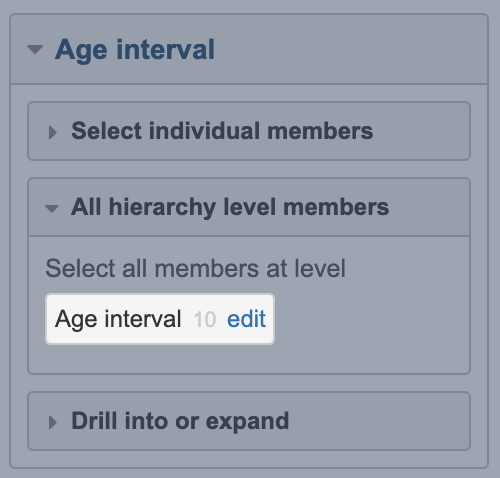Interval dimensions
Interval dimensions contain members that are intervals of some numeric attribute. For example, the Jira Issues cube has Age interval dimension which contains time intervals of unresolved issue age (time between the creation time and current time), and a Resolution interval which contains time intervals of resolved issue resolution time.
You can edit intervals from the dimension All hierarchy level members section by clicking on the edit link. Changes in interval definition will affect all reports in particular the flex.bi account.

If you import data from Jira, first you might want to import importing Age and Resolution interval dimensions. Go to flex.bi import options, tab Additional options, and mark the option to import interval dimensions.
Intervals
In the Edit Intervals dialog, you can enter a comma-separated list of intervals.
The simplest list of intervals is a list of interval end-points. For example 0,7,14,28 will create intervals:
(none)for values that were empty. These would be issues that are no longer due and do not fall into any of the age intervals.... - 00for values less than 000 - 06for values from 0 (including) to 7 (not including)07 - 13for values from 7 (including) to 14 (not including)14 - 27for values from 14 (including) to 28 (not including)28 - ...for values greater than 28
You can also specify an interval with from-to range and with an optional /step. For example, 0-30/10 will create intervals:
(none)... - 0000 - 0910 - 1920 - 2930 - ...
You can combine together a list of single end-points and a range with a step. For example, 0,7,14,30-100/10 will create intervals:
(none)... - 000000 - 006007 - 013014 - 029030 - 039- ...
090 - 099100 - ...
As you can see the number of leading zeros in the interval names will be calculated dynamically based on the largest interval end-point (to ensure that intervals are sorted correctly in ascending order).
By default /10 is used for interval generation which will group all values in the ranges using a step value 10.
Interval unit
If the interval dimension is based on a time duration (or age) then you can specify a time unit for interval values - days, hours, minutes, or seconds. By default days interval unit is used.
